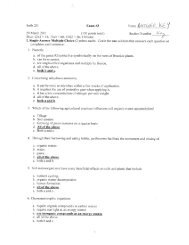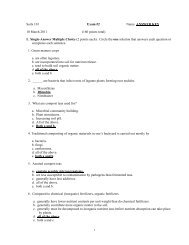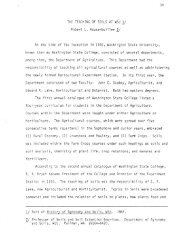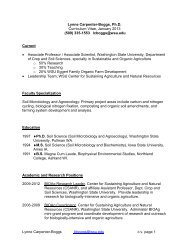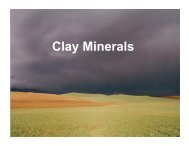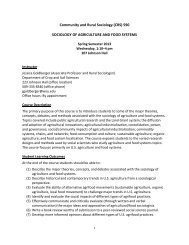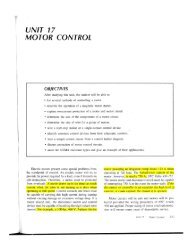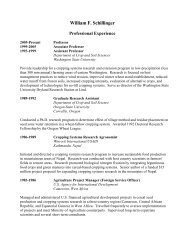2012 Dryland Field Day Abstracts - Dept. of Crop and Soil Sciences ...
2012 Dryland Field Day Abstracts - Dept. of Crop and Soil Sciences ...
2012 Dryland Field Day Abstracts - Dept. of Crop and Soil Sciences ...
You also want an ePaper? Increase the reach of your titles
YUMPU automatically turns print PDFs into web optimized ePapers that Google loves.
Part 3. Agronomy, Economics, <strong>and</strong> Sustainability Page 39<br />
production plots were harvested (2008 to 2011) <strong>and</strong> seed yield was determined (2011 data presented).<br />
Results for 2011 (4 th harvest) indicated that selection for seed yield components had a variable response <strong>and</strong> Kentucky bluegrass<br />
seed yield was primarily dependent on accession. Accession PI 368241 showed the best promise <strong>of</strong> being able to provide good<br />
turfgrass quality <strong>and</strong> seed yield under non-burn management in both non-irrigated <strong>and</strong> irrigated seed production (Fig. 1 <strong>and</strong> 2).<br />
One selection within Kenblue, seed/head, had good turfgrass quality <strong>and</strong> seed yield. These studies will be followed during <strong>2012</strong> to<br />
determine if the seed yields are sustainable.<br />
KBG seed yield (lbs/A)<br />
1000<br />
900<br />
800<br />
700<br />
600<br />
500<br />
400<br />
300<br />
200<br />
100<br />
PI 368241<br />
selections<br />
Kenblue<br />
seed/head<br />
0<br />
0 1 2 3 4 5 6 7<br />
Turfgrass quality<br />
Fig. 1. Kentucky bluegrass non-irrigated seed yield vs.<br />
turfgrass quality (rated 1-9; 9 = excellent quality) at Pullman,<br />
WA, 2011.<br />
Toward Better Prediction <strong>of</strong> Wind Erosion<br />
Brenton Sharratt, USDA-ARS <strong>and</strong> Venkat Vaddella, WSU, PULLMAN<br />
The Wind Erosion Prediction System (WEPS) was developed for assessing the impact <strong>of</strong> l<strong>and</strong> management practices on wind<br />
erosion <strong>and</strong> to identify l<strong>and</strong>s that are highly susceptible to wind erosion. Although WEPS has been tested <strong>and</strong> found to perform<br />
adequately across the Columbia Plateau, there have been many occasions when WEPS has failed to predict wind erosion during<br />
high wind events. Failure <strong>of</strong> WEPS to predict wind erosion is believed to be caused by overestimation <strong>of</strong> the threshold friction<br />
velocity <strong>of</strong> soils in the Columbia Plateau. Wind erosion only occurs when the friction velocity exceeds the threshold friction velocity<br />
<strong>of</strong> the surface, thus overestimation <strong>of</strong> threshold friction velocity will result in suppressed or no simulated erosion. Threshold<br />
friction velocities <strong>of</strong> soils found across the Columbia Plateau region are virtually unknown. We determined the threshold friction<br />
velocity <strong>of</strong> a s<strong>and</strong>y loam <strong>and</strong> four silt loams found in eastern Washington by systematically increasing wind speed <strong>and</strong><br />
simultaneously measuring saltation activity <strong>and</strong> dust (particles ≤100 µm in diameter) concentrations above the soil surface inside a<br />
wind tunnel. An increase in saltation activity or dust concentrations above background levels signified the attainment <strong>of</strong> the<br />
threshold friction velocity. The threshold friction velocity <strong>of</strong> the s<strong>and</strong>y loam was about 0.14 m s -1 (0.3 mph) whereas the threshold<br />
velocity <strong>of</strong> the four silt loams ranged from 0.19 to 0.25 m s -1 (0.4 to 0.6 mph). The threshold friction velocities measured in this<br />
study were lower than the minimum threshold velocity required to initiate erosion in WEPS. These low threshold friction velocities<br />
may contribute to the occasional failure <strong>of</strong> WEPS to predict wind erosion in the Columbia Plateau.<br />
Mild Freeze-thaw Cycles Improve Freezing Tolerance <strong>of</strong> Winter Wheat<br />
0<br />
0 1 2 3 4 5 6 7<br />
Turfgrass quality<br />
Dan Skinner, Kim Garl<strong>and</strong>-Campbell, <strong>and</strong> Brian Bellinger, USDA-ARS <strong>and</strong> <strong>Dept</strong>. <strong>of</strong> <strong>Crop</strong> <strong>and</strong> <strong>Soil</strong> <strong>Sciences</strong>, WSU<br />
Autumn months in winter wheat–growing regions typically experience significant rainfall <strong>and</strong> several days or weeks <strong>of</strong> mild<br />
subfreezing temperatures at night, followed by above-freezing temperatures in the day. Hence, the wheat plants usually are first<br />
exposed to potentially damaging subfreezing temperatures when they have high moisture content, are growing in very wet soil,<br />
<strong>and</strong> have been exposed to several mild freeze-thaw cycles. These conditions are conducive to freezing stresses <strong>and</strong> plant<br />
responses that are different from those that occur under lower moisture conditions without freeze-thaw cycles. We have studied<br />
the impact <strong>of</strong> mild subfreezing temperature <strong>and</strong> freeze-thaw cycles on the ability <strong>of</strong> 22 winter wheat cultivars to tolerate freezing<br />
in saturated soil. Seedlings that had been acclimated at +4°C for 5 weeks in saturated soil were frozen to potentially damaging<br />
temperatures (-14 to -16°C) under four treatment conditions: (1) without any freeze-thaw pre-freezing treatment; (2) with a freeze<br />
-thaw cycle <strong>of</strong> –3°C for 24 hours followed by +4°C for 24 hours, (3) as in treatment (2) but with thawing at +4°C for 48 hours after<br />
KBG seed yield (lbs/A)<br />
1200<br />
1100<br />
1000<br />
900<br />
800<br />
700<br />
600<br />
500<br />
400<br />
300<br />
200<br />
100<br />
PI 368241<br />
selections<br />
Kenblue<br />
seed/head<br />
Fig. 2. Kentucky bluegrass irrigated seed yield vs. turfgrass<br />
quality (rated 1-9; 9 = excellent quality) at Pullman, WA,<br />
2011.




